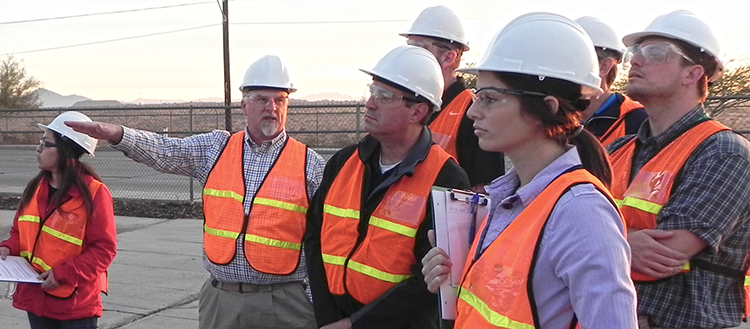We discuss how long a Phase I takes to complete and factors that influence the project length.
About a month ago we got a phone call from a group of investors who were looking to purchase a strip mall in an highly developed urban area. Long story short, they needed a Phase I done as fast as possible to meet a deadline. They wanted to know:
How long does a Phase I ESA take?
I'm glad they were asking because it's a vital question to the process, but unfortunately for them, they were quickly approaching a deadline in their purchasing process. I had to tell them that honestly, getting a Phase I ESA now could delay the process, especially if something unforeseen comes up that requires Phase II work.
Before we dive into it, if you're not sure what a Phase I ESA is, click that link to learn more. And, since you're probably wondering how much this whole process is going to cost you, read how much does a Phase I Environmental Site Assessment cost to get a good ballpark figure of what you can expect to pay.
How long do Phase I Environmental Site Assessments take?
I'd love to say 4 weeks and you're project is done, but that's not always the case. The answer is highly variable, and depends on several things, including some of the following:
Phase I timeframes depend on your location.
We've completed Phase I's on virgin land in a rural setting, with no development on or anywhere near the property, and the process was over and done with in about 2 weeks.
On the other hand, we're working on a project outside of New York City right now, and have an 1,800 page PDF to sift through, as well as visiting state, county, and city offices to review records. This job is going to be at least a month long process, possibly longer.
Additionally, if your site is located way outside of a city, or in an inaccessible place, you'll have to factor in travel time for a professional, and the time it takes him or her to travel to and from government offices to review files. While this will only add on a few days at the most, it's still time to consider.

Phase I's also depend on external factors beyond our control.
A Phase I is supposed to follow a standard set of steps, many of which take time due to interactions with 3rd party groups as well as the complexity of some of the tasks. For example, regulatory file reviews with multiple governmental agencies can, and normally does take a good amount of time. Some offices have restricted hours, or need appointments scheduled in advance, or only have paper files, meaning you have to sift through pages one by one looking for clues to the properties past.
A Phase I can be performed without some of this information, but these “data gaps” must be spelled out in the Phase I report, and the potential consequences of not having this information have to be discussed. Miss some information by being in a hurry, and you can get incomplete conclusions. This may not be worth the risk, and also can result in a Phase I that really doesn’t serve the purposes you expected in the first place.
Remember, a Phase I is looking for recognized environmental concerns at or adjacent to the property. Not sure what they are? Read what are RECs in a Phase I Environmental Site Assessment? to learn more.
And, if RECs are found, an environmental professional may suggest a Phase II ESA. Here we discuss what is a Phase II ESA to clear up what's going to happen should issues be found.

Is any additional work being included with the Phase I?
Some folks will want additional services conducted during a Phase I.
For instance, a lot of our clients who purchase an industrial operation will also hire us to conduct an environmental audit at the same time. It saves them time and money, and they'll get two separate reports on the facility they're looking to purchase. Additional work can, and almost always does, push the delivery date of the Phase I back.
As a reminder, there is a HUGE difference between environmental audits vs Phase I Environmental Site Assessments. If you're unsure what those differences are, click that link to read an article on the matter.
Additional Phase I ESA timeline factors.
There are other things that can influence the delivery date of a Phase I ESA, such as site access issues due to personnel needing to accompany you around the site, locked facilities, weather delays (all of which we've experienced), technical difficulties in receiving site records from regulators or other data providers, conducting interviews with current and past site personnel, etc.
We're not talking weeks' worth of delays, but if you're staring at a deadline, or need a report ASAP like these investors were, one or two days can make a world of difference.

So how long does a Phase I Environmental Site Assessment take from start to finish?
It can take anywhere from a few days (extremely quick and simple projects) to a month or more. As a general rule, we say a few weeks to a month or two is pretty average and should be sufficient.
For us, our standard turnaround time is usually 30 days. That allows us time to do what needs to be done, schedule and complete a site visit, and generate the report. While we’d always like more time, usually we can get it done in about a month. We also offer expedited services for those that really need their reports quicker, but we make it clear that some information may have to be sacrificed. Usually, that applies to those that request their reports in a couple of weeks or less.

Anyone who offers you a Phase I in a few days or so, or within a week or so without making it clear that this very well may sacrifice the quality of the work, and the results generated, is someone to be wary of. If your report is generated that quickly, there will be data gaps, and they must be addressed in order to conform with the standards. We see this a lot when people go with a low bidder, and honestly, they're throwing their money away. It sounds self-serving, but honestly, you should avoid a cheap Phase I. It's like going to the cheapest mechanic or doctor you can find. You're going to get what you pay for.
Anyone who understands and follows the standard requirements for a Phase I really can’t produce a quality product within a few days – you’re going to get less than what you need, or possibly even a report that doesn't follow the standards, making it completely useless should a problem arise down the road. Not sure what protection a Phase I offers? Click that link to read our article and learn more.
So the bottom line? Plan ahead and start thinking about your report early on. Allow enough time and be aware that the findings of the report can lead to the recommendation of further Phase II work, which can take even more time. Just remember, you don't always need a Phase II Environmental Site Assessment, and anyone who says you need one without a good reason is trying to hustle you for more money.
You’re far better off in the long run with an experienced Phase I ESA expert who takes the necessary amount of time to do the job right, and to provide you with what you really need. Otherwise, you’re really getting less than you need, and even maybe less than you’re paying for.
To learn more about Phase I work, click here to contact an expert or give us a call anytime at 609-693-8301 to learn more about the process.
















